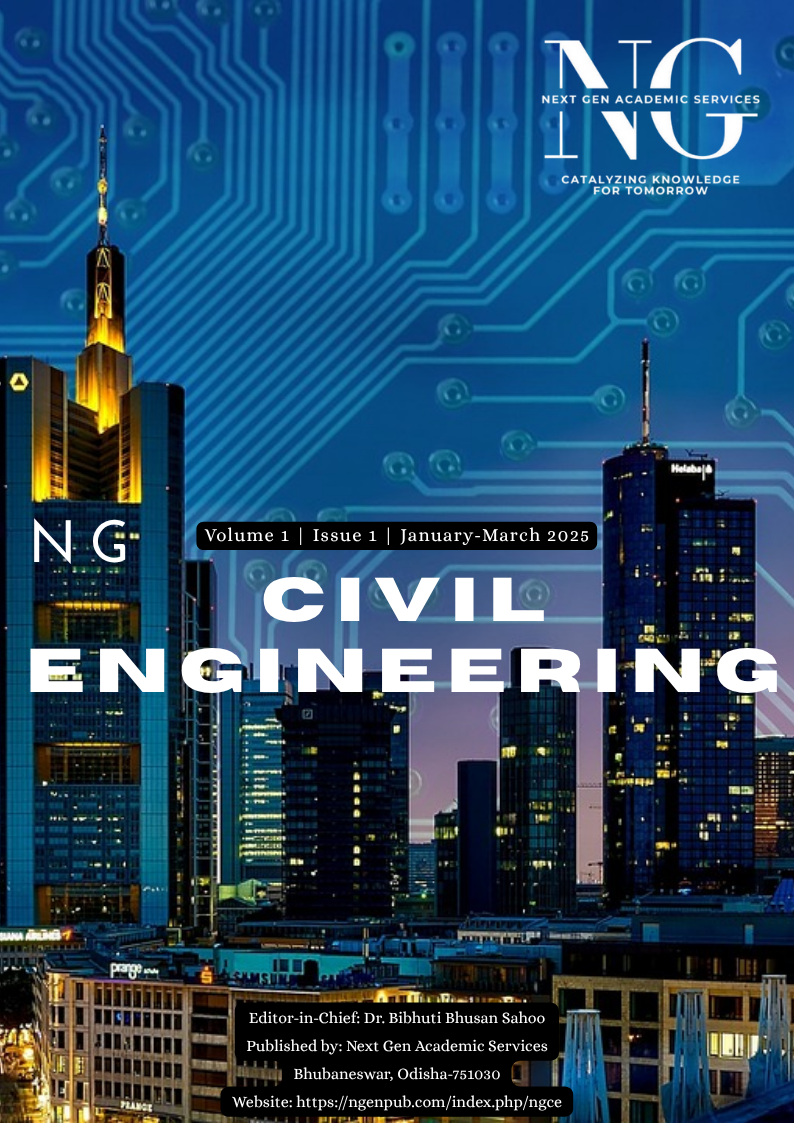Assessment of Soil Moisture Variability for Urban Flood Risk Mitigation
DOI:
https://doi.org/10.5281/zenodo.15390324Keywords:
Field Capacity, Infiltration, Soil Moisture Content, Specific GravityAbstract
Urban flooding has become a recurring problem in rapidly developing cities like Patna, primarily due to poor drainage, increased impervious surfaces, and a lack of integrated soil-based flood risk assessment. This study investigates the variability in soil moisture and its influence on urban flood susceptibility across selected locations in Patna. Soil samples were collected from ten urban sites and analyzed in the laboratory for texture (sand, silt, clay), water content, specific gravity, and field capacity. The results indicate a predominance of silt and clay-rich soils in many areas, particularly in Gulzarbagh, Gaighat, BIT, and Patrakar Nagar, contributing to low infiltration rates and increased surface runoff. Field capacity ranged from 9% to 21.41%, suggesting limited water retention capacity in several locations. The Soil Water Retention Curve (SWRC) was plotted using Brooks & Corey (1964), Campbell (1974), and Van Genuchten (1980) models with the help of SWRC v3.0 software to derive unsaturated hydraulic properties. Findings highlight that areas with finer-textured soils exhibit higher flood vulnerability due to reduced permeability and delayed infiltration. This soil-based assessment provides a scientific basis for integrating subsurface hydrological characteristics into urban flood mitigation and planning strategies for Patna and similar flood-prone urban centers.
Downloads
References
Avinash, S. (2013). Flood related disasters: concerned to urban flooding in Bangalore, India. Education, 2020.
Bansal, N., Mukherjee, M., & Gairola, A. (2015). Causes and impact of urban flooding in Dehradun. International Journal of Current Research, 7(2), 12615-12627.
Campbell, G. S. (1974). A simple method for determining unsaturated conductivity from moisture retention data. Soil science, 117(6), 311-314.
Crow, W. T., Berg, A. A., Cosh, M. H., Loew, A., Mohanty, B. P., Panciera, R., De Rosnay, P., Ryu, D., & Walker, J. P. (2012). Upscaling sparse ground‐based soil moisture observations for the validation of coarse‐resolution satellite soil moisture products. Reviews of Geophysics, 50(2).
Fredlund, D. G., & Xing, A. (1994). Equations for the soil-water characteristic curve. Canadian geotechnical journal, 31(4), 521-532.
Panahi, M., Rahmati, O., Kalantari, Z., Darabi, H., Rezaie, F., Moghaddam, D. D., Ferreira, C. S. S., Foody, G., Aliramaee, R., & Bateni, S. M. (2022). Large-scale dynamic flood monitoring in an arid-zone floodplain using SAR data and hybrid machine-learning models. Journal of Hydrology, 611, 128001.
Penna, D., Tromp-van Meerveld, H., Gobbi, A., Borga, M., & Dalla Fontana, G. (2011). The influence of soil moisture on threshold runoff generation processes in an alpine headwater catchment. Hydrology and Earth System Sciences, 15(3), 689-702.
Rafiq, F., Ahmed, S., Ahmad, S., & Khan, A. A. (2016). Urban floods in India. International Journal of Scientific & Engineering Research, 7(1), 721-734.
Van Genuchten, M. T. (1980). A closed‐form equation for predicting the hydraulic conductivity of unsaturated soils. Soil science society of America journal, 44(5), 892-898.
Yang, L., Sun, G., Zhi, L., & Zhao, J. (2018). Negative soil moisture-precipitation feedback in dry and wet regions. Scientific reports, 8(1), 4026.
Zhang, J., Zhou, L., Ma, R., Jia, Y., Yang, F., Zhou, H., & Cao, X. (2019). Influence of soil moisture content and soil and water conservation measures on time to runoff initiation under different rainfall intensities. Catena, 182, 104172.
Zhu, Y., Liu, Y., Wang, W., Singh, V. P., & Ren, L. (2021). A global perspective on the probability of propagation of drought: From meteorological to soil moisture. Journal of Hydrology, 603, 126907.





